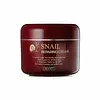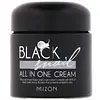What's inside
What's inside
 Key Ingredients
Key Ingredients

 Benefits
Benefits

 Concerns
Concerns

 Ingredients Side-by-side
Ingredients Side-by-side

Water
Skin ConditioningParaffinum Liquidum
EmollientGlycerin
HumectantPropylene Glycol
HumectantPolysorbate 60
EmulsifyingGlyceryl Stearate Se
EmulsifyingStearic Acid
CleansingCetearyl Alcohol
EmollientGlyceryl Stearate
EmollientTriethanolamine
BufferingSorbitan Sesquioleate
EmulsifyingDimethicone
EmollientCarbomer
Emulsion StabilisingPhenoxyethanol
PreservativeMethylparaben
PreservativeAllantoin
Skin ConditioningSodium Polyacrylate
AbsorbentXanthan Gum
EmulsifyingParfum
MaskingButylphenyl Methylpropional
PerfumingLinalool
PerfumingHexyl Cinnamal
PerfumingLimonene
PerfumingAlpha-Isomethyl Ionone
PerfumingSnail Secretion Filtrate
Skin ConditioningCamellia Sinensis Leaf Extract
AntimicrobialAloe Barbadensis Leaf Extract
EmollientWater, Paraffinum Liquidum, Glycerin, Propylene Glycol, Polysorbate 60, Glyceryl Stearate Se, Stearic Acid, Cetearyl Alcohol, Glyceryl Stearate, Triethanolamine, Sorbitan Sesquioleate, Dimethicone, Carbomer, Phenoxyethanol, Methylparaben, Allantoin, Sodium Polyacrylate, Xanthan Gum, Parfum, Butylphenyl Methylpropional, Linalool, Hexyl Cinnamal, Limonene, Alpha-Isomethyl Ionone, Snail Secretion Filtrate, Camellia Sinensis Leaf Extract, Aloe Barbadensis Leaf Extract
Snail Secretion Filtrate
Skin ConditioningNiacinamide
SmoothingHelianthus Annuus Seed Oil
EmollientCetearyl Olivate
Sorbitan Olivate
EmulsifyingButylene Glycol
HumectantSynthetic Wax
AbrasivePhenoxyethanol
PreservativeWater
Skin ConditioningEthylhexylglycerin
Skin ConditioningHydroxyethyl Acrylate/Sodium Acryloyldimethyl Taurate Copolymer
Emulsion StabilisingCarbomer
Emulsion StabilisingTriethanolamine
BufferingCaprylyl Glycol
EmollientSodium Polyacrylate
AbsorbentAdenosine
Skin ConditioningTropolone
Skin ConditioningCoptis Chinensis Root Extract
AntioxidantSorbitan Isostearate
EmulsifyingPolysorbate 60
EmulsifyingDisodium EDTA
Allantoin
Skin ConditioningPanthenol
Skin ConditioningGlycerin
HumectantTheobroma Cacao Extract
Skin ConditioningDextrin
AbsorbentTocopherol
Antioxidant1,2-Hexanediol
Skin ConditioningCentella Asiatica Extract
CleansingPalmitoyl Tripeptide-5
Skin ConditioningBeta-Glucan
Skin ConditioningCopper Tripeptide-1
Skin ConditioningSolanum Melongena Fruit Extract
Skin ConditioningCassia Obtusifolia Seed Extract
Skin ConditioningPorphyra Tenera Extract
Skin ConditioningFagus Sylvatica Seed Extract
Skin ConditioningDictyopteris Membranacea Extract
AntioxidantAllium Sativum Bulb Extract
Skin ConditioningPrunus Mume Fruit Extract
HumectantPolygonum Fagopyrum Seed Extract
Skin ConditioningRubus Coreanus Fruit Extract
Skin ConditioningMirabilis Jalapa Seed Extract
Skin ProtectingSepiolite
Charcoal Powder
AbrasiveAronia Melanocarpa Fruit Extract
Skin ConditioningEuterpe Oleracea Fruit Extract
Sambucus Nigra Fruit Extract
AstringentMorus Alba Fruit Extract
AntioxidantRhus Semialata Gall Extract
Skin ConditioningCinnamomum Cassia Bark Extract
MaskingInonotus Obliquus Extract
Skin ConditioningAnnona Cherimola Fruit Extract
Skin ConditioningCoffea Arabica Fruit Extract
AntioxidantVitis Vinifera Fruit Extract
Skin ConditioningCorthellus Shiitake Extract
Skin ProtectingPiper Nigrum Seed Extract
RefreshingSaccharum Officinarum Extract
MoisturisingRose Extract
Skin ConditioningSh-Oligopeptide-1
Skin ConditioningSnail Secretion Filtrate, Niacinamide, Helianthus Annuus Seed Oil, Cetearyl Olivate, Sorbitan Olivate, Butylene Glycol, Synthetic Wax, Phenoxyethanol, Water, Ethylhexylglycerin, Hydroxyethyl Acrylate/Sodium Acryloyldimethyl Taurate Copolymer, Carbomer, Triethanolamine, Caprylyl Glycol, Sodium Polyacrylate, Adenosine, Tropolone, Coptis Chinensis Root Extract, Sorbitan Isostearate, Polysorbate 60, Disodium EDTA, Allantoin, Panthenol, Glycerin, Theobroma Cacao Extract, Dextrin, Tocopherol, 1,2-Hexanediol, Centella Asiatica Extract, Palmitoyl Tripeptide-5, Beta-Glucan, Copper Tripeptide-1, Solanum Melongena Fruit Extract, Cassia Obtusifolia Seed Extract, Porphyra Tenera Extract, Fagus Sylvatica Seed Extract, Dictyopteris Membranacea Extract, Allium Sativum Bulb Extract, Prunus Mume Fruit Extract, Polygonum Fagopyrum Seed Extract, Rubus Coreanus Fruit Extract, Mirabilis Jalapa Seed Extract, Sepiolite, Charcoal Powder, Aronia Melanocarpa Fruit Extract, Euterpe Oleracea Fruit Extract, Sambucus Nigra Fruit Extract, Morus Alba Fruit Extract, Rhus Semialata Gall Extract, Cinnamomum Cassia Bark Extract, Inonotus Obliquus Extract, Annona Cherimola Fruit Extract, Coffea Arabica Fruit Extract, Vitis Vinifera Fruit Extract, Corthellus Shiitake Extract, Piper Nigrum Seed Extract, Saccharum Officinarum Extract, Rose Extract, Sh-Oligopeptide-1
Ingredients Explained
These ingredients are found in both products.
Ingredients higher up in an ingredient list are typically present in a larger amount.
Allantoin is a soothing ingredient known for its protective and moisturizingg properties. Because of this, it is often added to products with strong active ingredients.
Studies show higher concentrations of this ingredient can promote wound healing.
Though it can be derived from the comfrey plant, allantoin is produced synthetically for cosmetic products to ensure purity.
Learn more about AllantoinCarbomer is a polymer of acrylic acid. Its main role is to create a gel consistency.
A high amount of carbomer can cause pilling or balling up of products. Don't worry, most products contain 1% or less of carbomer.
Glycerin is already naturally found in your skin. It helps moisturize and protect your skin.
A study from 2016 found glycerin to be more effective as a humectant than AHAs and hyaluronic acid.
As a humectant, it helps the skin stay hydrated by pulling moisture to your skin. The low molecular weight of glycerin allows it to pull moisture into the deeper layers of your skin.
Hydrated skin improves your skin barrier; Your skin barrier helps protect against irritants and bacteria.
Glycerin has also been found to have antimicrobial and antiviral properties. Due to these properties, glycerin is often used in wound and burn treatments.
In cosmetics, glycerin is usually derived from plants such as soybean or palm. However, it can also be sourced from animals, such as tallow or animal fat.
This ingredient is organic, colorless, odorless, and non-toxic.
Glycerin is the name for this ingredient in American English. British English uses Glycerol/Glycerine.
Learn more about GlycerinPhenoxyethanol is a preservative that has germicide, antimicrobial, and aromatic properties. Studies show that phenoxyethanol can prevent microbial growth. By itself, it has a scent that is similar to that of a rose.
It's often used in formulations along with Caprylyl Glycol to preserve the shelf life of products.
Polysorbate 60 is used to help stabilize products. It is a surfactant and emulsifier. These properties help keep ingredients together in a product. Surfactants help reduce surface tension between ingredients with different states, such as liquids and solids. Emulsifiers help prevent oils and waters from separating.
Polysorbate 60 is sorbitol-based and created from the ethoxylation of sorbitan. Ethoxylation is a chemical reaction used to add ethylene oxide. Sorbitan is a the dehydrated version of sorbitol, a sugar found in fruits.
In this case, the 60 comes from reacting 60 units of ethylene oxide with sorbitan.
Polysorbates are commonly used in medicine and foods.
Learn more about Polysorbate 60Snail Secretion Filtrate is the excretion from snails. It is an effective moisturizer and promotes collagen production.
A popular nickname for this ingredient is 'Snail Mucin'.
Snail mucin has numerous skin benefits:
On top of this, Snail Secretion Filtrate contains a variety of vitamins and minerals. These include copper peptides, Vitamin A, and vitamin E. Vitamins A and E are antioxidants. Antioxidants help fight free-radicals that damage skin cells.
Being cruelty-free means a brand does not experiment on animals.
If you're worried about the well-being of the snails, we recommend looking more into the company of the product. Many brands have developed humane methods to collect snail mucin.
There is much debate on this subject. On one hand, this ingredient comes from an animal. On the other hand, many will argue the ingredient is naturally secreted (like a natural by-product) and therefore vegan. If you have reservations, you can look into Galactomyces Ferment Filtrate or Centella Asiatica Extract as alternatives.
Learn more about Snail Secretion FiltrateSodium Polyacrylate is the sodium salt of polyacrylic acid. It is used as an absorber, emollient, and stabilizer.
This ingredient is a super-absorbent polymer - meaning it can absorb 100 to 1000 times its mass in water. As an emollient, Sodium Polyacrylate helps soften and soothe skin. Emollients work by creating a barrier to trap moisture in. This helps keep your skin hydrated.
Triethanolamine is an emulsifier and pH adjuster. It is created using ethylene oxide and ammonia. This gives Triethanolamine a nitrogen core and a similar scent to ammonia.
As an emulsifier, it prevents ingredients from separating and enhances texture by adding volume to a product.
PH adjusters are common in cosmetic products. The pH of a product can affect the effectiveness of other ingredients. A product with a high pH may also irritate the skin.
Learn more about TriethanolamineWater. It's the most common cosmetic ingredient of all. You'll usually see it at the top of ingredient lists, meaning that it makes up the largest part of the product.
So why is it so popular? Water most often acts as a solvent - this means that it helps dissolve other ingredients into the formulation.
You'll also recognize water as that liquid we all need to stay alive. If you see this, drink a glass of water. Stay hydrated!
Learn more about Water